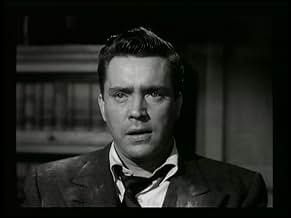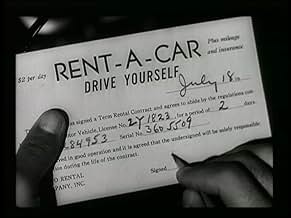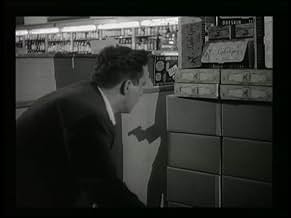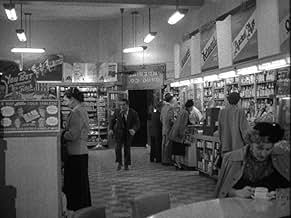Frank Bigelow, qui apprend qu'il a été empoisonné et qu'il ne lui reste que quelques jours à vivre, tente de découvrir qui l'a tué et pourquoi..Frank Bigelow, qui apprend qu'il a été empoisonné et qu'il ne lui reste que quelques jours à vivre, tente de découvrir qui l'a tué et pourquoi..Frank Bigelow, qui apprend qu'il a été empoisonné et qu'il ne lui reste que quelques jours à vivre, tente de découvrir qui l'a tué et pourquoi..
- Réalisation
- Scénario
- Casting principal
- Récompenses
- 2 victoires au total
- Miss Foster
- (as Beverly Campbell)
- Sue
- (as Cay Forrester)
- Dr. Matson
- (as Fred Jaquet)
- Dr. Schaefer
- (as Larry Dobkin)
- St. Francis Hotel Desk Clerk
- (non crédité)
Avis à la une
It starts with a bang, O'Brien staggering into the local homicide unit to tell the cops that there's been a murder - his, before launching into the massive flash-back which takes up pretty much the rest of the movie. The action from there on is hectic and as convoluted as all the best noirs are as O'Brien, infected by a deadly poison, races against the clock to track down his own killer and the reason behind it.
The film makes fine use of actual San Francisco and Los Angeles locations as well as authentically depicting the hot and steamy atmosphere at a Frisco jazz club. O'Brien is great as the doomed Bigelow, racing, often literally, against the clock, stopping only to palm off his adoring secretary girl-friend, Pamela Britten, who of course doesn't find out what's wrong with him until too late.
The pacing is almost non-stop once it gathers momentum, unfortunately when it does, some of the scene-writing gets over-ripe and correspondingly over-acted as O'Brien and his girl pour out their hearts somewhat unnecessarily. The film ends bravely though with a downbeat conclusion, delivering what the title says it must and at least tying up all the loose ends by that time.
This brings me to D.O.A., directed by Rudolf Maté. D.O.A. in my book is the Citizen Kane of the noirs. It's so good that I often wonder about how it got made in the first place. Since many of the people who were involved in its production are now no longer with us, I may never learn anything about its origins. That's a frustration, of course, but the more important thing is that I can recognize a great noir when I see it.
Why, you ask, is D.O.A. a great noir? The most obvious reason is its plot. A guy goes out for a night on the town and someone, a total stranger, slips him a mickey in a bar-a lethal mickey. But it doesn't kill him instantly. It kills him slowly, so slowly that he's given the chance to find out who did this terrible thing to him, and why.
Second, the film is exceptionally well made in every other respect. Okay, the Pamela Britton character is one dimensional and embarrassing, we all agree on that, but who really cares when everything else in the film is so good? Edmond O'Brien had one of the best roles of his career in D.O.A., and he took full advantage, though few critics give his performance much credit for the film's success.
O'Brien, a classically trained actor, plays a small-time Southern California businessman living his ordinary little life, minding his own business, regularly boffing his secretary (this was implied rather than made explicit; after all, this was 1949), and avoiding her whiney entreaties that they tie the knot, as he's been promising her he would do for ever so long.
You can't help liking O'Brien in part precisely because of his human flaws. He's basically decent, but harassed, overworked, and stretched to the limit by the pressure put on him by Britton. What adult male couldn't identify with this man, or at least sympathize? His very insignificance as one more human ant on the planet Earth, and the terrible thing that's about to happen to him, are the essence of great film noir. (Detour, although by no means a favorite noir of mine, is nevertheless another perfect example of an ordinary man, a small-timer, minding his own business and unexpectedly colliding with Fate and all that it has in store for him.) We resonate to D.O.A. because fate and contingency have been the fundamental conditions of life on the planet earth since before the beginning of history. Our time on Earth is brief and our lives but little scraps of paper blown about by the wind toward endings we know not. We live noir lives.
The film's particulars are wonderful. From the sunny hick town of Banning, the movie switches quickly to San Francisco. If ever there were a noir town, it's Frisco. (Hitchcock picked up on that real quick; watch Vertigo again to see how he saw the eerie side to that town, with its creepy deserted streets, little ghostlike fog-blown urban hills, and other abandoned places suggestive of loneliness and soullessness.)
From here one great noir scene follows another in astonishing succession: the smoky, crowded jazz bar where the sweaty black musicians are blowing up a storm (to an all-white 1949 audience of course), while a murder is silently committed with a switched drink. The doctor holding the eerily glowing glass tube of luminescent poison and informing O'Brien, "You've been murdered." O'Brien running through the crowded downtown streets like a madman, as if velocity could help him escape his fate. O'Brien, after being shot at, a gun now in his own hand, looking for his killer in the abandoned processing plant. His encounter with Luther Adler's insane, sadistic henchman played by Neville Brand. Brand, speaking softly, glints of spittle in the corners of his mouth, nutty little eyes lighting up with anticipated pleasure: "I'm gonna give it to you in the belly. You're soft in the belly, aren't'cha? " Then the fantastic night scene in the crowded Los Angeles drugstore with Brand stalking him among oblivious customers-till shots ring out, then screams, followed by death. Finally, again at night, O'Brien's confrontation with his killer, which (inevitably) occurs in the Bradbury Building, that great architectural shrine to noir, scene of so many other noir films.
Let's stop for a moment and go back to an earlier part of the film. Fatally poisoned, still not quite believing what has happened to him, exhausted and uncertain of anything, O'Brien has run for block after block, but now his energy has finally petered out and he finds himself alone near the docks. Utterly depleted, all hope lost, he wearily leans against the side of an old wooden newsstand in an otherwise bleak, abandoned area. Eyes glazing over, he's terrified, trying to catch his breath. During a medium close-up we briefly study him, then notice something to his left, a single long vertical row of magazines, all identical covers, arranged down the side of the kiosk just half a hand away from him. He isn't looking at them, isn't really aware of them, but we are. For just a few seconds we see: Life, Life, Life, Life, Life, Life, Life. Then the film quickly moves on and goes about its business, as if we had been shown nothing of importance.
You tell me this isn't a great film noir.
This memorable key scene portends his disconnection from those around him and represents a crack, however slight, in his life's foundation. Though initially reticent about socializing and imbibing with people he just met, he has unwittingly been thrust into a reality more threatening than is immediately apparent. Later in the film, a jarring example of his full blown isolation occurs when he finds himself in an outdoor, public area. In unbearable turmoil, he momentarily encounters a little girl innocently playing with a toy. She appears in soft lighting, contrasting starkly to the shadows surrounding Bigelow, whose face registers the painful shock of awareness that ordinary activity continues unabated even while he grapples with extreme danger. This is reinforced when seconds later he observes a young couple embracing, compounding his agonizing realization that all simple pleasures are now unattainable to him. Noticeably, when he is literally "up against the wall" his back is touching signage of "Life Magazine" logos. All that once comprised his own life, that which he had considered to be little more than mundane minutiae, is heightened in significance and irrevocably at stake.
It's an exciting B-thriller of vibrating pace that unites various elements as the fatalism , cynicism , corruption with a noir vision of America from the time . The original title belongs the notes about the deceased person . Magnificent interpretation by usually secondary Edmond O'Brien as when he is frantically running by San Francisco streets . The scene in which he runs in panic through the streets after learning he has been poisoned was a stolen shot . The pedestrians had no idea a movie was being made and no warning that Edmond O'Brien would be plowing through them . Nice secondary cast , being film debut of Beverly Garland and Neville Brand . The film gets a good black and white (though available colorized) cinematography with some excellent close-ups (the jazzmen) by Ernest Lazslo . Atmospheric music by the classic Dimitri Tiomkin . The movie is well done by Rudolph Mate , a famous and habitual cameraman . It's followed by inferior remakes as ¨Color me dead¨ (1969) with Tom Tryon and 1988 version with Dennis Quaid and Meg Ryan . The motion picture will appeal to dark noir movies fans . Rating : Notable and well worth seeing.
Anyhow, don't let those sappy early scenes fool you. They're necessary to set up the contrasting downspiral that ensues. As it happens, Frank Bigelow (O'Brien) may be bored with his accounting job in a quiet little town, along with the prospects of marrying a conventional girl, Paula (Britton), and living out a routine existence there. So, at the first chance there he goes, off to enjoy adventures in the big city, even if only brief ones. And get a load of the available women swarming around his San Francisco hotel. Now that adventure beckons, it's no longer thoughts of Banning or Paula. (But what was musical arranger Tiomkin thinking with those utterly cartoonish wolf whistles, perhaps the movie's only flaw).
So, along with the goodtime gang he's hooked up with, it's off to wild nightspots for the suddenly footloose Bigelow. The trouble is Frank has taken a big step away from the ordered simplicity of his small town and into the unfamiliar world of chaotic city life. And worse, the frenzied chaos of The Fisherman, its strung-out patrons and aggressive atmosphere, clouds the fact that his life will never be the same. In fact, the jazz scene with it's blaring, chaotic close-ups amounts to a superb one-of-a-kind metaphor for the bizarre world the small town accountant has now entered. Just as importantly, it makes anything that happens thereafter seem weirdly possible. As a result, when Frank swallows what turns out to be a deadly neon toxin, it seems perfectly in keeping with this landscape of disorder.
I may be biased, but O'Brien really deserved at least an Oscar nomination for his energetic and nuanced performance, as though Hollywood ever rewarded low-budget B-movies. In fact, I'm ready to enter him in the Olympics, for that 500-yard mad dash down Market Street. What a great natural reaction to the news that he's already a dead man. And filming the sequence with, I suspect, a hidden camera adds a kind of realism to the convoluted remainder of the whodunit.
Another high point is the sequence with the psychotic Chester (Brand). What a great piece of casting. Brand has such distinctive features, which he twists to full effect on the tormented Bigelow. But little does he know that Frank has acquired a peculiar kind of power. After all, what does he need to be afraid of since he's already dead. That scene in the drug store where Chester overplays his hand is another piece of fine filming and staging. I wouldn't be surprised that many in the audience have speculated with what they would do with Frank's kind of power, heavily purchased though it is.
What's so amazing about the movie is how adeptly the theme builds right down to the inevitable climax. We begin with a glimpse of a well-ordered world, but one that quickly descends into the depths of chaos and disorder, as Bigelow travels a nightmare road in pursuit of the where and why of his killer. I take the moral to be a conservative one, something like appreciating the routine and conventional, since it's never certain when an uncaring fate might intervene. After all, Frank really only comes to appreciate Paula and his small town once he's experienced its opposite. It's something that could happen to any of us, since even the most routine act may have unforeseen consequences. That's what's so unsettling about the movie.
Anyway, it's hats off to everyone involved in the making of this memorable noir. It's one of those submerged classics like Invasion of the Body Snatchers (1956) that surfaced only after a period on late night TV. Frankly, I still sometimes slip it out late at night, and pull up my socks real tight. To me, it's got that kind of staying power.
(In passing—living in LA, I occasionally pass the Bradbury Building and think of the movie. It looks pretty much the same as it did then, but has since acquired a kind of cachet among movie makers. I like to think it's because of the sweaty, underrated Eddie O'Brien and the unforgettable Frank Bigelow.)
Le saviez-vous
- AnecdotesThe scene in which Bigelow runs in panic through the streets after learning he has been poisoned was what is considered a 'stolen shot' where the pedestrians along the sidewalk had no idea a movie was being made and no warning that Edmond O'Brien would be plowing through them.
- GaffesAfter finding out who's in the photo, Bigelow leaves the photography studio and immediately starts getting shot at. He heads toward the factory (screen right) where the shots are supposed to be coming from, but all the shots being fired and ricocheting off the ground, pipe, barrel, etc. are coming from the other direction (screen left).
- Citations
[first lines]
Homicide Detective: Can I help you?
Frank Bigelow: I'd like to see the man in charge.
Homicide Detective: In here...
Frank Bigelow: I want to report a murder.
Homicide Captain: Sit down. Where was this murder committed?
Frank Bigelow: San Francisco, last night.
Homicide Captain: Who was murdered?
Frank Bigelow: I was.
- Crédits fousThe end credits read "The medical facts in this motion picture are authentic. Luminous toxin is a descriptive term for an actual poison. Technical Adviser, Edward F. Dunne, M.D."
- Versions alternativesAlso available in a colorized version.
- ConnexionsEdited into Déjà-vu (2000)
Meilleurs choix
- How long is D.O.A.?Alimenté par Alexa
Détails
- Date de sortie
- Pays d’origine
- Langue
- Aussi connu sous le nom de
- Bon pour la morgue
- Lieux de tournage
- Sociétés de production
- Voir plus de crédits d'entreprise sur IMDbPro
- Durée
- 1h 23min(83 min)
- Couleur
- Rapport de forme
- 1.37 : 1





































